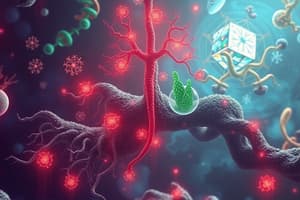Podcast
Questions and Answers
What is the primary product of cellular respiration?
What is the primary product of cellular respiration?
- Carbon Dioxide
- Glucose
- Oxygen
- ATP (correct)
Anaerobic respiration is more efficient than aerobic respiration.
Anaerobic respiration is more efficient than aerobic respiration.
False (B)
What role do mitochondria play in cellular respiration?
What role do mitochondria play in cellular respiration?
Mitochondria are the sites where aerobic respiration occurs, generating ATP through oxidation of organic molecules.
The process of breaking down glucose to release energy is known as ______.
The process of breaking down glucose to release energy is known as ______.
Match the following stages of cellular respiration with their descriptions:
Match the following stages of cellular respiration with their descriptions:
Flashcards
Cellular Respiration
Cellular Respiration
The process by which cells convert nutrients into energy (ATP).
ATP
ATP
Adenosine triphosphate, the main energy currency in cells.
Glycolysis
Glycolysis
The first step of cellular respiration, breaking glucose into pyruvate.
Citric Acid Cycle
Citric Acid Cycle
Signup and view all the flashcards
Aerobic vs Anaerobic Respiration
Aerobic vs Anaerobic Respiration
Signup and view all the flashcards
Study Notes
Cellular Respiration
- Cellular respiration is the primary mechanism cells use to produce energy, primarily ATP
- Key processes involve glucose oxidation
- Sequential stages, from glycolysis to the electron transport chain, are detailed
- Aerobic vs anaerobic respiration (fermentation) differences are highlighted
- Mitochondria's role is emphasized, specifically in the citric acid cycle and electron transport chain
Key Themes and Concepts
-
Respiration as the Main Source of Cellular Energy: Glucose breakdown produces energy, stored primarily in ATP.
- The overall glucose oxidation reaction is C6H12O6 + 6O2 → 6CO2 + 6H2O + Energy
- Energy is released, with some lost as heat
-
Sequential Stages of Glucose Oxidation:
- Glycolysis: Cytosol, glucose is split into two pyruvate molecules, yielding 2 ATP and 2 NADH.
- Citric Acid Cycle (Krebs Cycle): Pyruvate is oxidized in the mitochondrial matrix, forming acetyl CoA, and further oxidized in the cycle producing 1 ATP, three NADH, and one FADH2 molecule per acetyl group (two cycles per glucose molecule).
Electron Transport Chain (Oxidative Phosphorylation)
- Located in the inner mitochondrial membrane
- NADH and FADH2 donate high-energy electrons
- Electron transport chain powers proton pumping, creating a gradient
- ATP synthase uses gradient to produce ATP (chemiosmotic coupling)
The Role of Mitochondria
- Essential for respiration, particularly the citric acid cycle and the electron transport chain
- Critical processes occur in the inner mitochondrial membrane
ATP Production
- Aerobic respiration of one glucose molecule produces approximately 36 ATP molecules
- Most ATP is produced in the final stage of respiration, through oxidative phosphorylation in the mitochondria
- The inner mitochondrial membrane contains electron carrier proteins
Anaerobic Respiration (Fermentation)
- Occurs when oxygen is limited
- Pyruvate is converted to lactate or ethanol, producing significantly less ATP (2 ATP per glucose molecule)
- This is compared to the much efficient aerobic process
Metabolic Hub: The Citric Acid Cycle
- The citric acid cycle is central to catabolism and anabolism
- Glucose is the primary substrate, but other molecules (like fats and proteins) can also enter the cycle
- Catabolism is the breakdown of organic molecules to release energy; anabolism is the building of cellular components
Studying That Suits You
Use AI to generate personalized quizzes and flashcards to suit your learning preferences.




